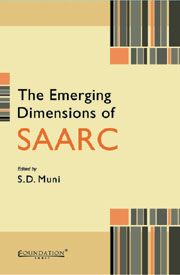Book contents
- Frontmatter
- Contents
- Preface
- List of Figures
- List of Tables
- 1 SAARC Prospects: The Changing Dimensions
- 2 SAARC and South Asian Economic Integration
- 3 Coping with the Emerging Challenges: Poverty and Food Security
- 4 SAARC Energy Cooperation: Energy Security and Environmental Challenges
- 5 Sub-Regional Cooperation under SAARC: An Economic Analysis
- 6 SAARC: Social Charter and Human Security
- 7 SAARC and the South Asian Security Architect
- 8 Fighting Terrorism through SAARC?
- 9 SAARC and the Evolving Asian Regionalism
- 10 Role of SAARC Observers: Members' Perspectives
- 11 Role of SAARC Observers: Observers' Perspectives
- 12 Concluding Remarks
- About the Contributors
- Index
1 - SAARC Prospects: The Changing Dimensions
Published online by Cambridge University Press: 26 October 2011
- Frontmatter
- Contents
- Preface
- List of Figures
- List of Tables
- 1 SAARC Prospects: The Changing Dimensions
- 2 SAARC and South Asian Economic Integration
- 3 Coping with the Emerging Challenges: Poverty and Food Security
- 4 SAARC Energy Cooperation: Energy Security and Environmental Challenges
- 5 Sub-Regional Cooperation under SAARC: An Economic Analysis
- 6 SAARC: Social Charter and Human Security
- 7 SAARC and the South Asian Security Architect
- 8 Fighting Terrorism through SAARC?
- 9 SAARC and the Evolving Asian Regionalism
- 10 Role of SAARC Observers: Members' Perspectives
- 11 Role of SAARC Observers: Observers' Perspectives
- 12 Concluding Remarks
- About the Contributors
- Index
Summary
Introduction
SAARC has completed 23 years of its formal institutional existence. This is a long period in the history of any international organisation to show its results. SAARC can claim considerable success in conceptual evolution and laying down of theoretical ground work, where a number of creative ideas on identifying South Asia's challenges and ways to address them through cooperative regionalism have been formulated, articulated and endorsed. The above is true for fields of trade and investments, in relation to developmental goals like poverty alleviation and food security, and even fighting terrorism. The Group of the Eminent Persons' Report; SAARC Social Charter; two reports of the Plan of Action on Poverty Alleviation by the specially established Commissions for the purpose; the SAARC Regional Convention on Suppression of Terrorism (conceived and concluded initially much before the 9/11 events) etc. may be recalled here. SAARC has also succeeded in stirring up regional consciousness of cooperation and collective action on various economic and social fronts across the borders in South Asia. This has resulted from a number of professional SAARC groups, of lawyers and doctors, journalists and academics, businessmen and entrepreneurs, and politicians and parliamentarians, engaging and interacting with each other beyond national boundaries under the SAARC flag raised outside the official meetings. SAARC's record however is still very unimpressive when it comes to translating the creative ideas and energies so unleashed, into concrete policy decisions and implementing them. Despite this, there is progress on South Asian Free Trade Area/ Agreement (SAFTA) and growing trade among its members.
- Type
- Chapter
- Information
- The Emerging Dimensions of SAARC , pp. 1 - 31Publisher: Foundation BooksPrint publication year: 2010
- 5
- Cited by

